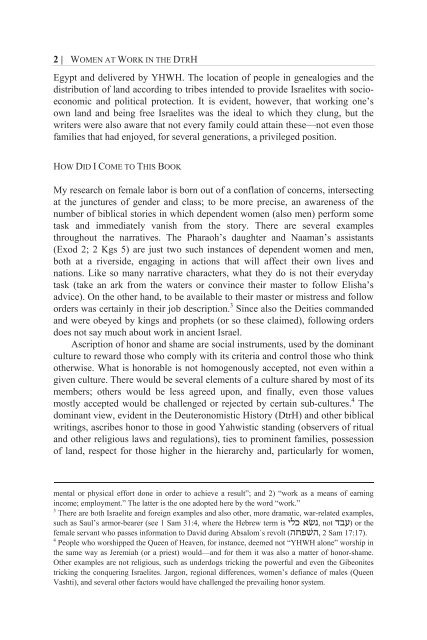Women at Work in the Deuteronomistic History - International Voices ...
Women at Work in the Deuteronomistic History - International Voices ...
Women at Work in the Deuteronomistic History - International Voices ...
You also want an ePaper? Increase the reach of your titles
YUMPU automatically turns print PDFs into web optimized ePapers that Google loves.
2 | WOMEN AT WORK IN THE DTRH<br />
Egypt and delivered by YHWH. The loc<strong>at</strong>ion of people <strong>in</strong> genealogies and <strong>the</strong><br />
distribution of land accord<strong>in</strong>g to tribes <strong>in</strong>tended to provide Israelites with socioeconomic<br />
and political protection. It is evident, however, th<strong>at</strong> work<strong>in</strong>g one’s<br />
own land and be<strong>in</strong>g free Israelites was <strong>the</strong> ideal to which <strong>the</strong>y clung, but <strong>the</strong><br />
writers were also aware th<strong>at</strong> not every family could <strong>at</strong>ta<strong>in</strong> <strong>the</strong>se—not even those<br />
families th<strong>at</strong> had enjoyed, for several gener<strong>at</strong>ions, a privileged position.<br />
HOW DID I COME TO THIS BOOK<br />
My research on female labor is born out of a confl<strong>at</strong>ion of concerns, <strong>in</strong>tersect<strong>in</strong>g<br />
<strong>at</strong> <strong>the</strong> junctures of gender and class; to be more precise, an awareness of <strong>the</strong><br />
number of biblical stories <strong>in</strong> which dependent women (also men) perform some<br />
task and immedi<strong>at</strong>ely vanish from <strong>the</strong> story. There are several examples<br />
throughout <strong>the</strong> narr<strong>at</strong>ives. The Pharaoh’s daughter and Naaman’s assistants<br />
(Exod 2; 2 Kgs 5) are just two such <strong>in</strong>stances of dependent women and men,<br />
both <strong>at</strong> a riverside, engag<strong>in</strong>g <strong>in</strong> actions th<strong>at</strong> will affect <strong>the</strong>ir own lives and<br />
n<strong>at</strong>ions. Like so many narr<strong>at</strong>ive characters, wh<strong>at</strong> <strong>the</strong>y do is not <strong>the</strong>ir everyday<br />
task (take an ark from <strong>the</strong> w<strong>at</strong>ers or conv<strong>in</strong>ce <strong>the</strong>ir master to follow Elisha’s<br />
advice). On <strong>the</strong> o<strong>the</strong>r hand, to be available to <strong>the</strong>ir master or mistress and follow<br />
orders was certa<strong>in</strong>ly <strong>in</strong> <strong>the</strong>ir job description. 3 S<strong>in</strong>ce also <strong>the</strong> Deities commanded<br />
and were obeyed by k<strong>in</strong>gs and prophets (or so <strong>the</strong>se claimed), follow<strong>in</strong>g orders<br />
does not say much about work <strong>in</strong> ancient Israel.<br />
Ascription of honor and shame are social <strong>in</strong>struments, used by <strong>the</strong> dom<strong>in</strong>ant<br />
culture to reward those who comply with its criteria and control those who th<strong>in</strong>k<br />
o<strong>the</strong>rwise. Wh<strong>at</strong> is honorable is not homogenously accepted, not even with<strong>in</strong> a<br />
given culture. There would be several elements of a culture shared by most of its<br />
members; o<strong>the</strong>rs would be less agreed upon, and f<strong>in</strong>ally, even those values<br />
mostly accepted would be challenged or rejected by certa<strong>in</strong> sub-cultures. 4 The<br />
dom<strong>in</strong>ant view, evident <strong>in</strong> <strong>the</strong> <strong>Deuteronomistic</strong> <strong>History</strong> (DtrH) and o<strong>the</strong>r biblical<br />
writ<strong>in</strong>gs, ascribes honor to those <strong>in</strong> good Yahwistic stand<strong>in</strong>g (observers of ritual<br />
and o<strong>the</strong>r religious laws and regul<strong>at</strong>ions), ties to prom<strong>in</strong>ent families, possession<br />
of land, respect for those higher <strong>in</strong> <strong>the</strong> hierarchy and, particularly for women,<br />
mental or physical effort done <strong>in</strong> order to achieve a result”; and 2) “work as a means of earn<strong>in</strong>g<br />
<strong>in</strong>come; employment.” The l<strong>at</strong>ter is <strong>the</strong> one adopted here by <strong>the</strong> word “work.”<br />
3 There are both Israelite and foreign examples and also o<strong>the</strong>r, more dram<strong>at</strong>ic, war-rel<strong>at</strong>ed examples,<br />
such as Saul’s armor-bearer (see 1 Sam 31:4, where <strong>the</strong> Hebrew term is ילכ אשׂנ, not דבע) or <strong>the</strong><br />
female servant who passes <strong>in</strong>form<strong>at</strong>ion to David dur<strong>in</strong>g Absalom´s revolt (החפשׁה, 2 Sam 17:17).<br />
4 People who worshipped <strong>the</strong> Queen of Heaven, for <strong>in</strong>stance, deemed not “YHWH alone” worship <strong>in</strong><br />
<strong>the</strong> same way as Jeremiah (or a priest) would—and for <strong>the</strong>m it was also a m<strong>at</strong>ter of honor-shame.<br />
O<strong>the</strong>r examples are not religious, such as underdogs trick<strong>in</strong>g <strong>the</strong> powerful and even <strong>the</strong> Gibeonites<br />
trick<strong>in</strong>g <strong>the</strong> conquer<strong>in</strong>g Israelites. Jargon, regional differences, women’s defiance of males (Queen<br />
Vashti), and several o<strong>the</strong>r factors would have challenged <strong>the</strong> prevail<strong>in</strong>g honor system.




